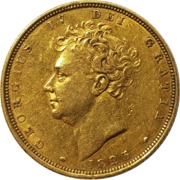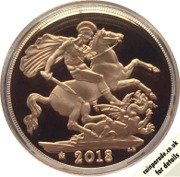
The 1825 Sovereign has King George IV's Head on the Obverse, but the mintage is a combination of four variants.
There are four variations of the 1825 Gold Sovereign, although the first two are the most common:
- Laurel Head (Roman style) with St George on reverse (shown right).
- Bare Head (designed by William Wyon) with Crowned Shield coat of arms on the reverse (the most common type of 1825 sovereign).
- Proof 7 heart semée (rare).
- Plain edge proof (rare).

The 1825 bare head sovereign was the first sovereign to be issued during the reign of King George IV featuring his bare head portrait.
Two different design sovereigns were issued in 1825. The first being the Laureate portrait (Reverse design of St George and the dragon), followed by the Bare portrait.
King George IV’s Head can be seen on the obverse of the coin, a shield of arms is depicted on the reverse.
The sovereign is made of 22 carat gold, and weighs 7.98 grams. It contains 0.2354 ounce of fine gold.
Sovereigns issued from 1817 to 1837 are often described as 'Early King' sovereigns. King George III, King George IV and King William IV are all depicted on sovereigns minted during these years.
Only 4,200,343 sovereigns were struck in 1825 (Bare head, Laureate head and others combined). It is very unlikely that all of these still exist today, as many have been melted down over the last two centuries.
The value of your sovereign will be heavily dependent on the date and condition.

 The 1825 Sovereign has King George IV's Head on the Obverse, but the mintage is a combination of four variants.
The 1825 Sovereign has King George IV's Head on the Obverse, but the mintage is a combination of four variants.  The 1825 bare head sovereign was the first sovereign to be issued during the reign of King George IV featuring his bare head portrait.
The 1825 bare head sovereign was the first sovereign to be issued during the reign of King George IV featuring his bare head portrait.